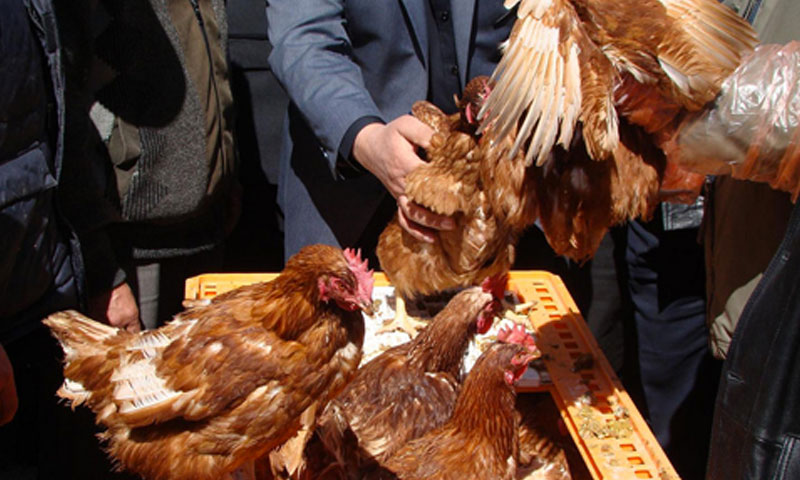



Homs – Orwa al-Mundhir | The use of white meat (chicken) in Syria, amid the high prices of red meat, opened the door for many people to invest in the breeding and production of poultry. In the northern countryside of Homs, some warehouses and farms have been transformed into poultry farms, to enter the market and compete with owners of large and licensed poultry projects.
However, these barns remained weak in the face of price fluctuations, because the price of one broiler depends on supply and demand in local markets.
The price of the broiler is also related to the prices of its supplies of feed and medicine, which are linked to the fluctuating exchange rate of the Syrian Pound against the Dollar, in addition to diseases, mortality rate and medicines expenses.
There are no accurate statistics on the number of poultry farms in the northern countryside of Homs, but Enab Baladi spotted their wide distribution in most of the cities of the region, ranging from Dar al Kabira and Talbiseh to Rastan, and from Zafarana to Houla farms and villages.
Entrance to poultry market
With the start of protests in Syria and the transition to military action, job opportunities decreased and a large number of employees were dismissed from government institutions. The financial resources of the families in general in the northern countryside of Homs were reduced. Small poultry barns, then, were one of the solutions to earn an income that would help families manage, especially with the losses suffered by the poultry sector in Syria since 2011.
According to a report by the UN Food and Agriculture Organization, published in September, Syria exported 76,000 tons of eggs in 2010, while production fell in 2014 by about 60%, according to the Syrian government website Fallahoun.
Abu Mohammed, a former employee from Rastan, told Enab Baladi that he had been fired since 2013. Back then, he had only a small farm, which has a medium-sized warehouse he has expanded and turned into a poultry barn. He explained: “I started raising poultry, because the capital cycle does not exceed 45 days, which brings me a semi-monthly income. The project does not require a large amount of time and is not tiring. He added that production is guaranteed 100%, but the profits are uneven and not guaranteed, because market price fluctuations play a major role in the ratio of profit and loss.
Last September, a report by the Food and Agriculture Organization (FAO) revealed that the number of chickens in Syria in 2018 amounted to 11 million.
Syrian Pound and Price fluctuations
Poultry farming is not subject to any laws that determine the cost of production, especially since the requirements of production are directly linked to the exchange rate. The latter is witnessing a state of instability and constant rise against the Dollar, reaching 750 Pounds to the Dollar, on November 23, according to currency website Syrian Pound Today.
As for the price of the broiler, it is related to the law of supply and demand, occasions and holidays, and all these were negative factors, causing huge losses sometimes for breeders, which compelled some of them to leave the market altogether.
Nasser, an old poultry breeder from Zafarana village, told Enab Baladi that raising poultry is a lucrative business in general. If the breeder has experience and large capital, he can bear losses in some sectors of the barn. After 40 days of breeding the chickens, the owner of the barn cannot keep them, even if the price is low. Every day that passes brings with it an increase in the quantity of feed that broilers eat, which means an increase in loss.
Nasser also pointed out that to avoid losses, barns’ owners breed more than one broiler sector to be in the market throughout the month. In the event of falling prices for one batch of chickens, there will be a rise in the next. This would achieve a balance between the loss in the first and profits in the second, but the ability to stay in the market needs several poultry barns and very large capital, as he put it.
Abu Ismail, a resident of the village of Houla, said that he tried working in poultry farming but did not succeed, because the high exchange rate raised the price of feed and medicines, and had a negative impact on the purchasing power of the residents of the region. All this made the work in the poultry sector a large risk, making him suffer losses that obliged him to stop working permanently.
During the past three months, the price of a kilo of broiler in Homs ranges between 650 and 750 Syrian Pounds, while the United Nations estimates that 83% of Syrians are below the poverty line, and 33% of them are food insecure, according to 2019 estimates.
if you think the article contain wrong information or you have additional details Send Correction